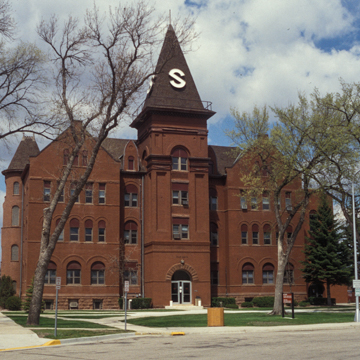You are here
Old Main, North Dakota State College of Science (Red River Valley University)
The state constitution established the North Dakota State College of Science (NDSCS), one of the oldest public two-year colleges in the nation. The campus incorporates the former site of the Wesleyan Red River Valley University (which closed in 1905 and relocated to a new campus in Grand Forks in 1906), with Old Main as its centerpiece. Old Main has experienced alterations, including the removal of two ogee-shaped parapets on the gable-end side wings and a diminutive dormer from the tower, but the distinctive “S” logo (for Science) now ornaments the tower on all four faces of its spire. The building sits on the north side of the main campus oval that was designed by Minneapolis-based landscape architects Morell and Nichols. In 1909 three buildings were added to the campus: a women’s dormitory, chemistry building, and central heating plant. Building upon a 1921 study of the academic program by Dean Earl J. Babcock of the School of Mines at the University of North Dakota (the Babcock Plan), NDSCS continues to serve as the state’s most up-to-date, comprehensive technical/trade school.
Writing Credits
If SAH Archipedia has been useful to you, please consider supporting it.
SAH Archipedia tells the story of the United States through its buildings, landscapes, and cities. This freely available resource empowers the public with authoritative knowledge that deepens their understanding and appreciation of the built environment. But the Society of Architectural Historians, which created SAH Archipedia with University of Virginia Press, needs your support to maintain the high-caliber research, writing, photography, cartography, editing, design, and programming that make SAH Archipedia a trusted online resource available to all who value the history of place, heritage tourism, and learning.







